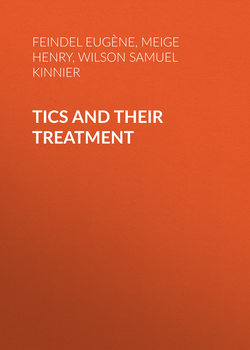Читать книгу Tics and Their Treatment - Feindel Eugène - Страница 8
CHAPTER III
THE PATHOGENY OF TIC
TIC AND CO-ORDINATION
ОглавлениеWe have thus come to see that a tic is a co-ordinated, systematised, purposive act. The majority of observers are satisfied on this point, although there exist various differences of opinion, more apparent than real, the inevitable result of disagreement as to the interpretation of certain expressions. It is imperative to obviate misunderstanding once and for all.
In his first contribution to the study of the disease which bears his name, Gilles de la Tourette gave the general description of motor inco-ordination to the convulsive movements of his patients. It has been argued by Guinon, on the contrary, that they are really systematised, and that they reproduce, in an involuntary manner, the co-ordinated movements of everyday life. That this is sometimes the case Tourette subsequently admitted, but he still professed their frequent actual inco-ordination.
This divergence of opinion is entirely attributable to difference of interpretation. Littré's definition of muscular inco-ordination is, "A condition occurring in various diseases of the nervous system, in which the patient cannot co-ordinate the necessary muscular movements for walking, grasping an object, etc." In this sense the term is applicable indiscriminately to the gesticulations of choreic, athetotic, or tic patients; to the ataxia of tabetics and others; to the tremor of disseminated sclerosis or paralysis agitans, etc. An expression so general is not merely of no diagnostic value; it leads to positive confusion.
It is precisely in the type of inco-ordination that the difference lies. As rigorous a distinction must be drawn between the gestures of chorea and the gesticulations of the sufferer from tic as between the tremor of insular sclerosis and of Parkinson's disease.
In assigning an exact meaning to the term muscular inco-ordination, we cannot do better than quote the remarks of Guinon:
The tabetic who throws his legs to right and left, who as he sits at table cannot carry his spoon to his mouth, furnishes an instance of true motor inco-ordination. On the other hand, the subject of tic performs his voluntary actions with perfect assurance; though his infirmity occasion all sorts of ridiculous involuntary arm movements, he never brings his fork against his ear or his cheek, nor does he spill a drop from his glass; his walk may be interrupted by a sudden halt to bend his knees and kneel, or to strike his foot violently on the ground, but he never trips one leg over the other and never falls.
In his article in the Dictionnaire Jaccoud, Letulle distinguishes two kinds of tics:
The convulsive tic consists of a series of partial convulsions, while the co-ordinated tic is the expression of some complex act by a sequence of muscular contractions for that purpose. In the former case the resulting movement is irregular, abnormal, and useless; it is a muscular "shock" evolved without reason and continued without effect… The normal individual usually possesses in potentia all the elements for the genesis of a co-ordinated tic. Some little trick or mannerism, arising perhaps from the necessity of gaining time for reflection, or from the desire of concealing some innate timidity, or of dissimulating some preoccupation, becomes sooner or later involuntary and automatic, and though maintaining its regularity and co-ordination, passes insensibly into the realm of pathology.
The distinction, however, is far from being absolute. Letulle himself admits it is a question of degree rather than of kind; the co-ordinated tic differs from the first variety only in its greater extent, complexity, and duration. Now, the convulsive tic may be a local, partial, irregular, abnormal convulsion, yet these characteristics are not sufficient to differentiate it: biting the lips is classed by Letulle as a co-ordinated tic, but it is surely a local, partial, irregular, abnormal muscular act; and the explosive laryngeal "ahem!" he would similarly place, yet it cannot be said to be a phenomenon characterised by its extent, complexity, and duration.
According to Guinon, a further distinguishing feature of the convulsive tic is its frequent though inopportune reproduction of some reflex or automatic purposive movement of everyday life, whereas we have just seen that one of the elements in Letulle's co-ordinated tic is its purposiveness. In a word, these observers apply the same epithet to two varieties of tic which they are endeavouring to separate.
The explanation of the apparent contradiction is simple. A gesture which seems meaningless and useless to-day becomes intelligible and logical to-morrow, when we learn the reason for it. In the course of an attack of conjunctivitis a patient acquires the habit of winking his eye, and though the inflammation subsides, the habit persists. If we are ignorant of its cause, are we to call the tic convulsive since it appears to us needless? And if we do know its origin; can we say it is co-ordinated when one muscle only is involved in the contraction?
The distinction drawn by Letulle between the two groups may hold good in some cases, but certainly not in all, and in our opinion it is preferable to abstain entirely from the attempt to base a classification on variation in muscular contraction. Noir remarks very justly that intermediate forms occur which are difficult to place in one or other category. In face of the confusion to which an illogical division inevitably leads, we may safely leave this question aside. In our view, the motor phenomena of the disease are always systematic, co-ordinated movements, directed for the attainment of some definite object. We exclude all simple bulbar or spinal reflexes, and all spasms, since the cardinal feature in these conditions is the absence of any functional systematisation.
